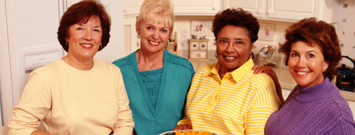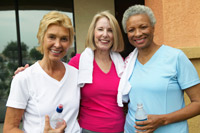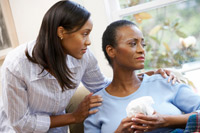Cancer and Women
 Every year, cancer claims the lives of more than a quarter of a million women in America. Women can reduce their cancer risk by adopting a healthy lifestyle and getting the right cancer screening tests for their stage of life.
Every year, cancer claims the lives of more than a quarter of a million women in America. Women can reduce their cancer risk by adopting a healthy lifestyle and getting the right cancer screening tests for their stage of life.
Lifestyle Changes
Tobacco Use and Secondhand Smoke
More women in the United States die from lung cancer than any other type of cancer, and cigarette smoking causes most cases. Smoking also causes cancers of the esophagus, larynx (voice box), mouth, throat, kidney, bladder, pancreas, stomach, uterine cervix, and acute myeloid leukemia. Nonsmokers who are exposed to secondhand smoke at home or work increase their lung cancer risk by 20%–30%. Concentrations of many cancer-causing and toxic chemicals are higher in secondhand smoke than in the smoke inhaled by smokers.
One of the most important things you can do to lower your risk of cancer is to stop smoking if you smoke, and avoid secondhand smoke.
Obesity, Overweight, and Lack of Physical Activity
 For more than 30 years, excess weight, lack of physical activity, and an unhealthy diet have been considered second only to tobacco use as preventable causes of disease and death in the United States. Since the 1960s, tobacco use has decreased by a third while obesity rates have doubled.
For more than 30 years, excess weight, lack of physical activity, and an unhealthy diet have been considered second only to tobacco use as preventable causes of disease and death in the United States. Since the 1960s, tobacco use has decreased by a third while obesity rates have doubled.
The following six cancers are associated with being overweight: breast cancer among postmenopausal women, colorectal cancer, endometrial cancer, esophageal adenocarcinoma (a type of cancer of the tube that connects your throat to your stomach), and cancer of the kidney and pancreas.
Adopting a lifestyle that includes healthy eating and regular physical activity can help prevent these cancers.
Sun Safety
Skin cancer is the most common form of cancer in the United States. The two most common types of skin cancer—basal cell and squamous cell carcinomas—are highly curable. But melanoma, the third most common skin cancer, is more dangerous. About 65%–90% of melanomas are caused by exposure to ultraviolet (UV) light—an invisible kind of radiation that comes from the sun, tanning beds, and sunlamps.
A few serious sunburns can increase your risk of skin cancer. To protect your skin from the sun, seek shade or go indoors during midday hours; wear long sleeves and long pants, a hat with a wide brim, and sunglasses; use sunscreen with a sun protective factor (SPF) of 15 or higher; and avoid indoor tanning.
Types of Cancer
Breast Cancer
 Breast cancer is the most common cause of cancer and the second most common cause of cancer deaths in American women. Mammograms are the best way to find breast cancer early, before it can be felt, and when it is easier to treat. If you're 40–49 years old, talk to your doctor about when to start getting mammograms. If you're 50–74 years old, get a screening mammogram every two years.
Breast cancer is the most common cause of cancer and the second most common cause of cancer deaths in American women. Mammograms are the best way to find breast cancer early, before it can be felt, and when it is easier to treat. If you're 40–49 years old, talk to your doctor about when to start getting mammograms. If you're 50–74 years old, get a screening mammogram every two years.
Colorectal (Colon) Cancer
The third leading cause of cancer deaths in American women is colorectal cancer. Screening tests for colorectal cancer can find precancerous polyps so they can be removed before they turn into cancer. Screening tests also can find colorectal cancer early, when treatment works best. Everyone should be tested for colorectal cancer regularly starting at age 50.
Gynecologic Cancers
Gynecologic cancers start in a woman's cervix, ovaries, uterus, vagina, vulva, or rarely, fallopian tubes. You can take steps to prevent some of these cancers.
Pap tests can find abnormal cells that may turn into cervical cancer. Removal of the abnormal cells prevents cervical cancer. Pap tests can also find cervical cancer early, when the chance of being cured is very high. The only cancer for which the Pap test screens is cervical cancer. It does not screen for ovarian, uterine, vaginal, or vulvar cancers.
The human papillomavirus (HPV) vaccine is available for girls and women who are 9–26 years old. It protects against most types of HPV that most often cause cervical cancer.
In addition to the Pap test, the HPV test may be used for screening women who are 30 years old or older, or at any age for those who have unclear Pap test results.
Survivorship
Cancer Survivors
A cancer survivor is a person who has been diagnosed with cancer, from the time of diagnosis to the end of his or her life. Cancer survivors largely consist of people who are 65 years of age or older and women. Of the 11.7 million people living with cancer in 2007, 6.3 million were women. The largest group of cancer survivors were breast cancer survivors (22%). Women are more likely to be survivors because cancers among women, such as breast and cervical cancer, usually occur at a younger age and can be found early and treated successfully.
Cancer Patient Caregivers
People who have cancer often live at home, and get help from informal caregivers—people who help them without being paid. Informal caregivers are usually the cancer patient's spouse, family members, friends, or neighbors, and the majority of caregivers are women.
Many people get a sense of personal fulfillment from taking care of a loved one who has cancer. But informal caregivers usually face physical, emotional, and financial problems that vary according to the amount and kind of care the patient needs. Taking time for yourself can help you be a better caregiver. The National Cancer Institute has tips on how cancer caregivers also can care for themselves.
More Information
- Cancer Prevention
- Lung Cancer
- Breast Cancer
- Colorectal Cancer
- Gynecologic Cancers
- Cancer Among Women
- HPV and Cancer
- Women's Health
- Breast and Ovarian Cancer and Family Health History
Listen to or download a podcast:
- Quit Smoking for Your Family's Sake [PODCAST - 0:59 minutes] (2008)
- Get Your Mammogram! [PODCAST - 4:17 minutes] (2010)
- Take Time to Save Your Life [PODCAST - 3:27 minutes] (2008)
- Women: Be Aware [PODCAST - 3:27 minutes] (2008)
- Don't Pass on this Test [PODCAST - 4:29 minutes] (2008)
Send an eCard to family and friends:
 Lung Cancer (Women) |  Mammograms Save Lives |  Cervical Cancer |
 Colorectal Cancer |  Gynecologic Cancers: What You Need to Know |
CDC works 24/7 saving lives and protecting people from health threats to have a more secure nation. A US federal agency, CDC helps make the healthy choice the easy choice by putting science and prevention into action. CDC works to help people live longer, healthier and more productive lives.
Get email updates
To receive email updates about this page, enter your email address:
Contact Us:
- Centers for Disease Control and Prevention
1600 Clifton Rd
Atlanta, GA 30333 - 800-CDC-INFO
(800-232-4636)
TTY: (888) 232-6348 - cdcinfo@cdc.gov



